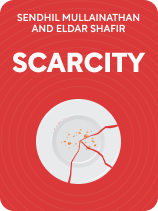

This article is an excerpt from the Shortform book guide to "Scarcity" by Sendhil Mullainathan and Eldar Shafir. Shortform has the world's best summaries and analyses of books you should be reading.
Like this article? Sign up for a free trial here.
How does poverty affect one’s cognitive functioning? What are the psychological consequences of never having enough money?
Poverty takes a huge toll on one’s cognitive capacity. Poor people are so preoccupied with stretching their money that they don’t have any mental bandwidth to focus on anything else. The cognitive effects of poverty should be tackled on the institutional level.
Here are some recommended poverty alleviation programs from Scarcity.
1. Educational Programming
The first poverty alleviation program from Scarcity is educational programming. Mullainathan and Shafir suggest that educational programs provide classes on a rolling basis so that people don’t have to drop out of a program if they miss one session. Since poor people are more likely to have other tasks pulling their attention away from a class (which isn’t an urgent need), this strategy makes it easier for people to participate even if they can’t consistently show up. For example, if a class consists of four different sessions, stagger the start dates so that if someone misses a session, they can join a different group where they left off.
(Shortform note: This strategy focuses on improving education programs for poor adults, but many people argue that we should focus on improving education for children in low-income families to alleviate the impacts of poverty. This is because poor students in the US are concentrated in public schools with fewer resources, making students less likely to finish school and less likely to escape poverty. Mullainathan and Shafir’s strategy of providing parallel classes could potentially be adapted for young students by providing tutoring to prevent kids from falling behind during the school year if they miss class or failed part of the curriculum.)
The authors also emphasize the importance of offering rules of thumb that are easy to remember instead of overloading people with information they won’t be able to process and retain. For example, “always pay off your highest-interest debt first” is a rule of thumb that can make more impact than a lengthy course on financial strategies. This strategy also takes into account the scarcity of time that poor people are more likely to experience because it’s less time-consuming to communicate rules of thumb.
(Shortform note: Some research suggests that rules of thumb are a cost-effective way to communicate financial strategies. However, other examples illustrate ways that rules of thumb can lead people astray when the rule shouldn’t be applied in a specific context. For example, one nutritional rule of thumb is that we should “eat the rainbow,” meaning that we should eat foods of all different colors to consume diverse nutrients. But this rule could be used to justify eating only rainbow-colored gummy bears or colorful donuts, which is inadvisable from a nutritional standpoint.)
Lastly, Mullainathan and Shafir urge organizations not to focus solely on educational efforts (like classes about nutrition or why it’s important to take your medications) that tax people’s limited time and mental bandwidth. Instead, Mullainathan and Shafir recommend shifting to concrete strategies, like reminders to take medicine. This targets people’s tendency to forget important tasks instead of trying to convince people that tasks such as medication adherence are important.
(Shortform note: Since the book was published, Mullainathan’s nonprofit, ideas42, has successfully implemented a few programs based on this strategy. For example, in two different pilot projects, text message reminders for court appearances increased attendance and decreased arrest warrants issued for failing to show up in court. Reminders to apply for recertification also helped participants in the Special Supplemental Nutrition Program for Women, Infants, and Children keep their benefits.)
2. Social Program Applications
Another strategy to improve social programs is to help people fill out forms and applications since many people miss out on the benefits they qualify for because forms and applications are often tedious, time-consuming, and require many forms of documentation. The authors’ research shows that assisting people with applications in person increases participation rates.
(Shortform note: In addition to helping people fill out forms and applications, simplifying the applications for social programs (for example, by reducing requirements for multiple in-person appointments) would reduce the bandwidth required to participate. On the other hand, language barriers also prevent non-English speaking people from applying for social benefits in the US, illustrating a deterrent to participation that goes beyond the mental bandwidth shortage.)
3. Childcare
Mullainathan and Shafir also argue that reducing the burden of childcare through free or heavily subsidized childcare options can go a long way in freeing up the mental bandwidth of low-income people. They emphasize that childcare requires lots of high-level cognitive functions, and without consistent childcare options, people may also have to juggle transportation and other logistic arrangements with multiple people helping with childcare.
(Shortform note: Research in the US reveals that childcare is a major financial burden for poor families. The US Department of Health and Human Services claims that affordable childcare should cost less than 7% of a family’s income, but only one state (Louisiana) meets this standard for the median family income. In addition to taxing people’s mental bandwidth, consequences of unaffordable childcare include decreased productivity for workplaces (due to parents missing work for childcare), lost wages and fewer retirement benefits for parents who have to leave the workforce, and harmful effects on kids from unregulated and substandard childcare.)
4. Financial Policies and Programs
The authors also highlight the benefits of changing high-fee payday loans so that some of the fees go toward a savings account for the borrower. They explain that this leverages peoples’ instinct to opt for a quick solution to urgent needs while also reducing the risk of them spiraling into debt. It would also help people establish a financial buffer that can cover unexpected and emergency expenses.
(Shortform note: The US Consumer Financial Protection Bureau regulates payday loans at the federal level, but individual states still have widely varying payday loan regulations around interest rates and fees. Mullainathan and Shafir aren’t clear about how this kind of reform would be implemented, but there are several advocacy groups working to provide better consumer information and lobby for policy changes.)
Lastly, employers can help stabilize employees’ income and mitigate the harmful effects of scarcity by providing them with a consistent schedule and paying them more frequently. Mullainathan and Shafir suggest that a stable income would also stabilize people’s mental bandwidth.
In the case of farmers, who are both self-employed and may only receive income at harvest time once a year, Mullainathan and Shafir recommend a financial product that distributes a farmer’s income over the course of a year. This would reduce periods of extreme abundance and scarcity, making farmers more efficient with their monthly income and freeing up mental bandwidth when their money from the previous harvest is low.
(Shortform note: Mullainathan and Shafir don’t go into detail on these financial policies or who would be incentivized to participate. Labor unions are one example of an institution that already protects minimum work hours. However, outside of unions, it’s unlikely that employers would have an incentive to do the same, except perhaps to increase employee retention. For the authors’ example of spreading out farmer income, there’s no evidence that farmers would be willing to participate in this kind of program. In addition, farmers have the unique challenge of expenses that vary greatly throughout the season for things like seed, fertilizer, and labor, so their income needs might also vary from the norm.)

———End of Preview———
Like what you just read? Read the rest of the world's best book summary and analysis of Sendhil Mullainathan and Eldar Shafir's "Scarcity" at Shortform.
Here's what you'll find in our full Scarcity summary:
- An exploration of the good and bad sides of a scarcity mindset
- Strategies to counteract the negative cognitive effects of scarcity
- How policymakers should redesign social programs






